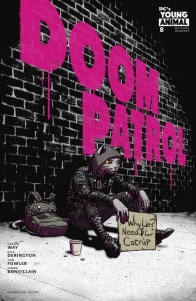Gerard Way and Nick Derrington return for “Doom Patrol”’s first conventional issue in over four months. It’s a good thing their version of conventional is anything but ordinary. Spoilers ahead.
Written by Gerard WayCover by Nick Derrington
Penciled by Nick Derrington
Inked by Tom Fowler
Colored by Tamara Bonvillain
Lettered by Todd KleinWhat is S**t, and why is everyone eating it? Cliff doesn’t like it, but Casey can’t get enough. Sure, Cliff doesn’t like a lot of stuff, but that doesn’t mean he’s wrong to be suspicious this time around. Meanwhile, we find out where Lotion the cat got off to, and how his journey has changed him. Life on the streets has made him an entirely different animal!
I love “Doom Patrol.” No caveats, no irony, no tricky phrasing. Not the team (though I do love them too), not the concept (though it is wonderful). I love “Doom Patrol,” the book by Gerard Way, Nick Derrington, and the rest of the team, and this issue only reminded me of that fact. It also reminded me that this love is not unrequited: “Doom Patrol” is itself a love letter to comics and those who read them.
This becomes apparent from the two-page opener, which uses plainclothes workers in a scene that makes the most of comic storytelling techniques. We have the use of the same framing for two panels with only one aspect having moved, to show motion. We have the sudden use of a contrasting color to signify something strange afoot. We have the use of just-unintelligible lettering to showcase someone speaking just too low to be heard. All fairly standard techniques, though used well. And then there’s the concepts on those pages.
On the surface, the storytelling seems ordinary. Visually, everything mostly makes sense. These people are in an office space filled with filing cabinets. Then, however, you really look. Not only are there filing cabinets, there are also comic book longboxes lining the tops of the ten-feet-tall filing cabinets. And then they pull open one of the filing cabinets to reveal . . . well, not documents. Likewise, in terms of the words, everything almost makes sense. You immediately understand who these people are, what their relationship is, and the type of thing they’re doing. But you don’t exactly know the details of what they’re doing. Their conversation flows naturally and makes a modicum of sense, in the way something would if it were leading to something more. Until that further development happens, though, the scene on its own will still be completely mysterious . . . unless you think deeper.
On deeper reflection, it’s clear this scene is about comic book creators and their decisions to pull characters out from obscurity. Everything the two characters say points to this — at one point, a character suggests the other “go into the longs and pull something out” in a panel framed looking down from the longboxes — and the visuals follow as well. They literally pull a pink, featureless human-like figure out of a filing cabinet and run some scans on it, as if testing whether the character would work in this story and how to reconfigure it if it doesn’t. In this case, as with many others in “Doom Patrol,” the visuals are equally as important as the words, both serving a basic storytelling function on the surface but coming together to represent something completely different. Further, it’s a collaborative effort that could only be done in a visual medium like comics.
Then there’s the bit in the last few panels where I don’t actually know what they’re talking about. They mention “Archie.” Is this referring to Archie Goodwin, longtime DC editor? Archie Comics, the publisher? Someone or something completely different? By not telling us, Way leaves it to our imaginations, ensuring we get the most out of the book by re-reading the scenes with different hypotheses. A love letter to comics, a love letter to fans, and a brilliantly way to get the readers to react in the way they always like to.
Things only get more wild from there, as every single page is packed with ideas. My favorite thing about these ideas is how Way and Derrington portray these wild ideas in such creatively ordinary ways. It’s not enough for Casey’s cat Lotion to have returned as an anthropomorphic creature. He’s also a posterchild for wayward punk youth. Danny, the sentient ambulance that’s actually a world capable of creating anything, hijacks a debriefing slideshow to point out Casey’s temper by displaying, in a no-frills, sans-serif font, the word “TEMPER.” This mixture of the ordinary and extraordinary is “Doom Patrol”’s most unique quality, either keeping us grounded just long enough so we can get swept off our feet again, or getting us so used to the odd that the small moments of ordinary have an even greater impact. It’s a niche style that would never attain the necessary budget for a movie or TV show, but can as a comic.
As the tentpole Young Animal book, “Doom Patrol” still stands as the firmest example of the line’s mission statement. It’s niche while welcoming all who want to read. It’s completely bizarre in the most ordinary ways. It makes just too little sense so that you want to lean in and think deeper. And most of all, it loves its audience and invites us to love it.
Final Verdict: 9.0 – This is true, unrestrained comic book joy.







